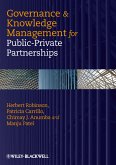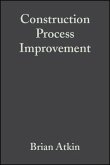Knowledge Management in Construction (eBook, PDF)
Redaktion: Anumba, Chimay J.; Carrillo, Patricia; Egbu, Charles
109,99 €
109,99 €
inkl. MwSt.
Sofort per Download lieferbar

0 °P sammeln
109,99 €
Als Download kaufen

109,99 €
inkl. MwSt.
Sofort per Download lieferbar

0 °P sammeln
Jetzt verschenken
Alle Infos zum eBook verschenken
109,99 €
inkl. MwSt.
Sofort per Download lieferbar
Alle Infos zum eBook verschenken

0 °P sammeln
Knowledge Management in Construction (eBook, PDF)
Redaktion: Anumba, Chimay J.; Carrillo, Patricia; Egbu, Charles
- Format: PDF
- Merkliste
- Auf die Merkliste
- Bewerten Bewerten
- Teilen
- Produkt teilen
- Produkterinnerung
- Produkterinnerung

Bitte loggen Sie sich zunächst in Ihr Kundenkonto ein oder registrieren Sie sich bei
bücher.de, um das eBook-Abo tolino select nutzen zu können.
Hier können Sie sich einloggen
Hier können Sie sich einloggen
Sie sind bereits eingeloggt. Klicken Sie auf 2. tolino select Abo, um fortzufahren.

Bitte loggen Sie sich zunächst in Ihr Kundenkonto ein oder registrieren Sie sich bei bücher.de, um das eBook-Abo tolino select nutzen zu können.
A key problem facing the construction industry is that all work is done by transient project teams, and in the past there has been no structured approach to learning from projects once they are completed. Now, though, the industry is adapting concepts of knowledge management to improve the situation.
This book brings together 13 contributors from research and industry to show how managing construction knowledge can bring real benefits to organisations and projects. It covers a wide range of issues, from basic definitions and fundamental concepts, to the role of information technology, and…mehr
- Geräte: PC
- mit Kopierschutz
- eBook Hilfe
- Größe: 1.33MB
Andere Kunden interessierten sich auch für
![Governance and Knowledge Management for Public-Private Partnerships (eBook, PDF) Governance and Knowledge Management for Public-Private Partnerships (eBook, PDF)]() Herbert RobinsonGovernance and Knowledge Management for Public-Private Partnerships (eBook, PDF)95,99 €
Herbert RobinsonGovernance and Knowledge Management for Public-Private Partnerships (eBook, PDF)95,99 €![Capture and Reuse of Project Knowledge in Construction (eBook, PDF) Capture and Reuse of Project Knowledge in Construction (eBook, PDF)]() Hai Chen TanCapture and Reuse of Project Knowledge in Construction (eBook, PDF)107,99 €
Hai Chen TanCapture and Reuse of Project Knowledge in Construction (eBook, PDF)107,99 €![Strategic Management in Construction (eBook, PDF) Strategic Management in Construction (eBook, PDF)]() David LangfordStrategic Management in Construction (eBook, PDF)73,99 €
David LangfordStrategic Management in Construction (eBook, PDF)73,99 €![Construction Process Improvement (eBook, PDF) Construction Process Improvement (eBook, PDF)]() Construction Process Improvement (eBook, PDF)103,99 €
Construction Process Improvement (eBook, PDF)103,99 €![Corporate Strategy in Construction (eBook, PDF) Corporate Strategy in Construction (eBook, PDF)]() Steven MccabeCorporate Strategy in Construction (eBook, PDF)64,99 €
Steven MccabeCorporate Strategy in Construction (eBook, PDF)64,99 €![Construction Project Management (eBook, PDF) Construction Project Management (eBook, PDF)]() S. Keoki SearsConstruction Project Management (eBook, PDF)113,99 €
S. Keoki SearsConstruction Project Management (eBook, PDF)113,99 €![Best Value in Construction (eBook, PDF) Best Value in Construction (eBook, PDF)]() Best Value in Construction (eBook, PDF)58,99 €
Best Value in Construction (eBook, PDF)58,99 €-
-
-
A key problem facing the construction industry is that all work is done by transient project teams, and in the past there has been no structured approach to learning from projects once they are completed. Now, though, the industry is adapting concepts of knowledge management to improve the situation.
This book brings together 13 contributors from research and industry to show how managing construction knowledge can bring real benefits to organisations and projects. It covers a wide range of issues, from basic definitions and fundamental concepts, to the role of information technology, and engendering a knowledge sharing culture. Practical examples from construction and other industry sectors are used throughout to illustrate the various dimensions of knowledge management. The challenges of implementing knowledge management are outlined and the ensuing benefits highlighted.
This book brings together 13 contributors from research and industry to show how managing construction knowledge can bring real benefits to organisations and projects. It covers a wide range of issues, from basic definitions and fundamental concepts, to the role of information technology, and engendering a knowledge sharing culture. Practical examples from construction and other industry sectors are used throughout to illustrate the various dimensions of knowledge management. The challenges of implementing knowledge management are outlined and the ensuing benefits highlighted.
Dieser Download kann aus rechtlichen Gründen nur mit Rechnungsadresse in D ausgeliefert werden.
Produktdetails
- Produktdetails
- Verlag: John Wiley & Sons
- Erscheinungstermin: 8. Mai 2008
- Englisch
- ISBN-13: 9780470759523
- Artikelnr.: 38201398
- Verlag: John Wiley & Sons
- Erscheinungstermin: 8. Mai 2008
- Englisch
- ISBN-13: 9780470759523
- Artikelnr.: 38201398
- Herstellerkennzeichnung Die Herstellerinformationen sind derzeit nicht verfügbar.
Chimay Anumba is Professor of Construction Engineering and Informatics, and Founding Director of the Centre for Innovative Construction Engineering, at Loughborough University. Charles Egbu is Professor of Construction and Project Management at Glasgow Caledonian University. Patricia Carrillo is Senior Lecturer in Construction Management in the Department of Civil & Building Engineering, Loughborough University.
Chapter 1 INTRODUCTION. Chapter 2 NATURE AND DIMENSIONS OF KNOWLEDGE MANAGEMENT. 2.1 Introduction
2.2 Why knowledge management now? The Drivers
2.3 Nature of knowledge
2.4 Extra organisational knowledge and absorptive capacity
2.5 Key knowledge processes
2.6 Conclusions. Chapter 3 CONSTRUCTION AS A KNOWLEDGE-BASED INDUSTRY. 3.1 Introduction
3.2 Construction industry and knowledge intensive products and services
3.3 Knowledge production in Construction
3.4 Communicating and sharing knowledge
3.5 Creating and sustaining a knowledge culture
3.6 Conclusions. Chapter 4 THE BUSINESS CASE FOR KNOWLEDGE MANAGEMENT. 4.1 Introduction
4.2 What does Knowledge Management mean to Construction?
4.3 What Knowledge Management strategy should be adopted?
4.4 Delivering Knowledge Management in practice
4.5 A business case for Knowledge Management
4.6 The Future. Chapter 5 ORGANISATIONAL READINESS FOR KNOWLEDGE MANAGEMENT. 5.1 Introduction
5.2 Importance of knowledge lifecycle management (KLM)
5.3 Preparing the organisational context for KLM
5.4 Conclusions. Chapter 6 TOOLS AND TECHNIQUES FOR KNOWLEDGE MANAGEMENT. 6.1 Introduction
6.2 Knowledge management tools
6.3 Selecting Knowledge management tools
6.4 The SeLEKT approach
6.5 Conclusions. Chapter 7 CROSS-PROJECT KNOWLEDGE MANAGEMENT. 7.1 Introduction
7.2 Nature of projects
7.3 Construction projects
7.4 Cross project knowledge transfer
7.5 Live capture and re-use of project knowledge
7.6 Conclusions. Chapter 8 KNOWLEDGE MANAGEMENT AS A DRIVER FOR INNOVATION. 8.1 Introduction
8.2 Knowledge management and innovations - building and maintaining capabilities
8.3 Knowledge management and improved innovations: Issues of strategy, process, structure, culture and technology
8.4 Managing knowledge for exploitations: Implications for managers
8.5 Conclusions. Chapter 9 PERFORMANCE MEASUREMENT IN KNOWLEDGE MANAGEMENT. 9.1 Introduction
9.2 Why measure the performance of knowledge management and knowledge assets
9.3 Types of performance measures
9.4 Measurement approaches
9.5 Application tools
9.6 Conclusions. Chapter 10 KM STATEGY DEVELOPMENT: A CLEVER APPROACH. 10.1 Introduction
10.2 The CLEVER project
10.3 The Clever Framework
10.4 Utilisation and Evaluation of the Framework
10.5 Conclusions
. Chapter 11 CORPORATE MEMORY. 11.1 Introduction
11.2 Research Methodology
11.3 Related Research
11.4 Tacit knowledge, capture, sharing and reuse
11.5 Tacit and explicit knowledge capture, sharing and reuse
11.6 Conclusions. Chapter 12 BUILDING A KNOWLEDGE SHARING CULTURE IN CONSTRUCTION PROJECT TEAMS. 12.1 Introduction
12.2 Case study
12.3 Discussion
12.4 Conclusions. Chapter 13 CONCLUDING NOTES. 13.1 Introduction
13.2 Summary
13.3 Benefits of knowledge management to construction organisations
13.4 Issues in knowledge management implementation
Future directions
2.2 Why knowledge management now? The Drivers
2.3 Nature of knowledge
2.4 Extra organisational knowledge and absorptive capacity
2.5 Key knowledge processes
2.6 Conclusions. Chapter 3 CONSTRUCTION AS A KNOWLEDGE-BASED INDUSTRY. 3.1 Introduction
3.2 Construction industry and knowledge intensive products and services
3.3 Knowledge production in Construction
3.4 Communicating and sharing knowledge
3.5 Creating and sustaining a knowledge culture
3.6 Conclusions. Chapter 4 THE BUSINESS CASE FOR KNOWLEDGE MANAGEMENT. 4.1 Introduction
4.2 What does Knowledge Management mean to Construction?
4.3 What Knowledge Management strategy should be adopted?
4.4 Delivering Knowledge Management in practice
4.5 A business case for Knowledge Management
4.6 The Future. Chapter 5 ORGANISATIONAL READINESS FOR KNOWLEDGE MANAGEMENT. 5.1 Introduction
5.2 Importance of knowledge lifecycle management (KLM)
5.3 Preparing the organisational context for KLM
5.4 Conclusions. Chapter 6 TOOLS AND TECHNIQUES FOR KNOWLEDGE MANAGEMENT. 6.1 Introduction
6.2 Knowledge management tools
6.3 Selecting Knowledge management tools
6.4 The SeLEKT approach
6.5 Conclusions. Chapter 7 CROSS-PROJECT KNOWLEDGE MANAGEMENT. 7.1 Introduction
7.2 Nature of projects
7.3 Construction projects
7.4 Cross project knowledge transfer
7.5 Live capture and re-use of project knowledge
7.6 Conclusions. Chapter 8 KNOWLEDGE MANAGEMENT AS A DRIVER FOR INNOVATION. 8.1 Introduction
8.2 Knowledge management and innovations - building and maintaining capabilities
8.3 Knowledge management and improved innovations: Issues of strategy, process, structure, culture and technology
8.4 Managing knowledge for exploitations: Implications for managers
8.5 Conclusions. Chapter 9 PERFORMANCE MEASUREMENT IN KNOWLEDGE MANAGEMENT. 9.1 Introduction
9.2 Why measure the performance of knowledge management and knowledge assets
9.3 Types of performance measures
9.4 Measurement approaches
9.5 Application tools
9.6 Conclusions. Chapter 10 KM STATEGY DEVELOPMENT: A CLEVER APPROACH. 10.1 Introduction
10.2 The CLEVER project
10.3 The Clever Framework
10.4 Utilisation and Evaluation of the Framework
10.5 Conclusions
. Chapter 11 CORPORATE MEMORY. 11.1 Introduction
11.2 Research Methodology
11.3 Related Research
11.4 Tacit knowledge, capture, sharing and reuse
11.5 Tacit and explicit knowledge capture, sharing and reuse
11.6 Conclusions. Chapter 12 BUILDING A KNOWLEDGE SHARING CULTURE IN CONSTRUCTION PROJECT TEAMS. 12.1 Introduction
12.2 Case study
12.3 Discussion
12.4 Conclusions. Chapter 13 CONCLUDING NOTES. 13.1 Introduction
13.2 Summary
13.3 Benefits of knowledge management to construction organisations
13.4 Issues in knowledge management implementation
Future directions
Chapter 1 INTRODUCTION. Chapter 2 NATURE AND DIMENSIONS OF KNOWLEDGE MANAGEMENT. 2.1 Introduction
2.2 Why knowledge management now? The Drivers
2.3 Nature of knowledge
2.4 Extra organisational knowledge and absorptive capacity
2.5 Key knowledge processes
2.6 Conclusions. Chapter 3 CONSTRUCTION AS A KNOWLEDGE-BASED INDUSTRY. 3.1 Introduction
3.2 Construction industry and knowledge intensive products and services
3.3 Knowledge production in Construction
3.4 Communicating and sharing knowledge
3.5 Creating and sustaining a knowledge culture
3.6 Conclusions. Chapter 4 THE BUSINESS CASE FOR KNOWLEDGE MANAGEMENT. 4.1 Introduction
4.2 What does Knowledge Management mean to Construction?
4.3 What Knowledge Management strategy should be adopted?
4.4 Delivering Knowledge Management in practice
4.5 A business case for Knowledge Management
4.6 The Future. Chapter 5 ORGANISATIONAL READINESS FOR KNOWLEDGE MANAGEMENT. 5.1 Introduction
5.2 Importance of knowledge lifecycle management (KLM)
5.3 Preparing the organisational context for KLM
5.4 Conclusions. Chapter 6 TOOLS AND TECHNIQUES FOR KNOWLEDGE MANAGEMENT. 6.1 Introduction
6.2 Knowledge management tools
6.3 Selecting Knowledge management tools
6.4 The SeLEKT approach
6.5 Conclusions. Chapter 7 CROSS-PROJECT KNOWLEDGE MANAGEMENT. 7.1 Introduction
7.2 Nature of projects
7.3 Construction projects
7.4 Cross project knowledge transfer
7.5 Live capture and re-use of project knowledge
7.6 Conclusions. Chapter 8 KNOWLEDGE MANAGEMENT AS A DRIVER FOR INNOVATION. 8.1 Introduction
8.2 Knowledge management and innovations - building and maintaining capabilities
8.3 Knowledge management and improved innovations: Issues of strategy, process, structure, culture and technology
8.4 Managing knowledge for exploitations: Implications for managers
8.5 Conclusions. Chapter 9 PERFORMANCE MEASUREMENT IN KNOWLEDGE MANAGEMENT. 9.1 Introduction
9.2 Why measure the performance of knowledge management and knowledge assets
9.3 Types of performance measures
9.4 Measurement approaches
9.5 Application tools
9.6 Conclusions. Chapter 10 KM STATEGY DEVELOPMENT: A CLEVER APPROACH. 10.1 Introduction
10.2 The CLEVER project
10.3 The Clever Framework
10.4 Utilisation and Evaluation of the Framework
10.5 Conclusions
. Chapter 11 CORPORATE MEMORY. 11.1 Introduction
11.2 Research Methodology
11.3 Related Research
11.4 Tacit knowledge, capture, sharing and reuse
11.5 Tacit and explicit knowledge capture, sharing and reuse
11.6 Conclusions. Chapter 12 BUILDING A KNOWLEDGE SHARING CULTURE IN CONSTRUCTION PROJECT TEAMS. 12.1 Introduction
12.2 Case study
12.3 Discussion
12.4 Conclusions. Chapter 13 CONCLUDING NOTES. 13.1 Introduction
13.2 Summary
13.3 Benefits of knowledge management to construction organisations
13.4 Issues in knowledge management implementation
Future directions
2.2 Why knowledge management now? The Drivers
2.3 Nature of knowledge
2.4 Extra organisational knowledge and absorptive capacity
2.5 Key knowledge processes
2.6 Conclusions. Chapter 3 CONSTRUCTION AS A KNOWLEDGE-BASED INDUSTRY. 3.1 Introduction
3.2 Construction industry and knowledge intensive products and services
3.3 Knowledge production in Construction
3.4 Communicating and sharing knowledge
3.5 Creating and sustaining a knowledge culture
3.6 Conclusions. Chapter 4 THE BUSINESS CASE FOR KNOWLEDGE MANAGEMENT. 4.1 Introduction
4.2 What does Knowledge Management mean to Construction?
4.3 What Knowledge Management strategy should be adopted?
4.4 Delivering Knowledge Management in practice
4.5 A business case for Knowledge Management
4.6 The Future. Chapter 5 ORGANISATIONAL READINESS FOR KNOWLEDGE MANAGEMENT. 5.1 Introduction
5.2 Importance of knowledge lifecycle management (KLM)
5.3 Preparing the organisational context for KLM
5.4 Conclusions. Chapter 6 TOOLS AND TECHNIQUES FOR KNOWLEDGE MANAGEMENT. 6.1 Introduction
6.2 Knowledge management tools
6.3 Selecting Knowledge management tools
6.4 The SeLEKT approach
6.5 Conclusions. Chapter 7 CROSS-PROJECT KNOWLEDGE MANAGEMENT. 7.1 Introduction
7.2 Nature of projects
7.3 Construction projects
7.4 Cross project knowledge transfer
7.5 Live capture and re-use of project knowledge
7.6 Conclusions. Chapter 8 KNOWLEDGE MANAGEMENT AS A DRIVER FOR INNOVATION. 8.1 Introduction
8.2 Knowledge management and innovations - building and maintaining capabilities
8.3 Knowledge management and improved innovations: Issues of strategy, process, structure, culture and technology
8.4 Managing knowledge for exploitations: Implications for managers
8.5 Conclusions. Chapter 9 PERFORMANCE MEASUREMENT IN KNOWLEDGE MANAGEMENT. 9.1 Introduction
9.2 Why measure the performance of knowledge management and knowledge assets
9.3 Types of performance measures
9.4 Measurement approaches
9.5 Application tools
9.6 Conclusions. Chapter 10 KM STATEGY DEVELOPMENT: A CLEVER APPROACH. 10.1 Introduction
10.2 The CLEVER project
10.3 The Clever Framework
10.4 Utilisation and Evaluation of the Framework
10.5 Conclusions
. Chapter 11 CORPORATE MEMORY. 11.1 Introduction
11.2 Research Methodology
11.3 Related Research
11.4 Tacit knowledge, capture, sharing and reuse
11.5 Tacit and explicit knowledge capture, sharing and reuse
11.6 Conclusions. Chapter 12 BUILDING A KNOWLEDGE SHARING CULTURE IN CONSTRUCTION PROJECT TEAMS. 12.1 Introduction
12.2 Case study
12.3 Discussion
12.4 Conclusions. Chapter 13 CONCLUDING NOTES. 13.1 Introduction
13.2 Summary
13.3 Benefits of knowledge management to construction organisations
13.4 Issues in knowledge management implementation
Future directions







